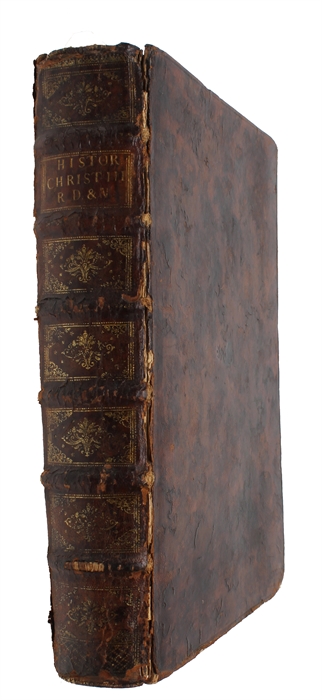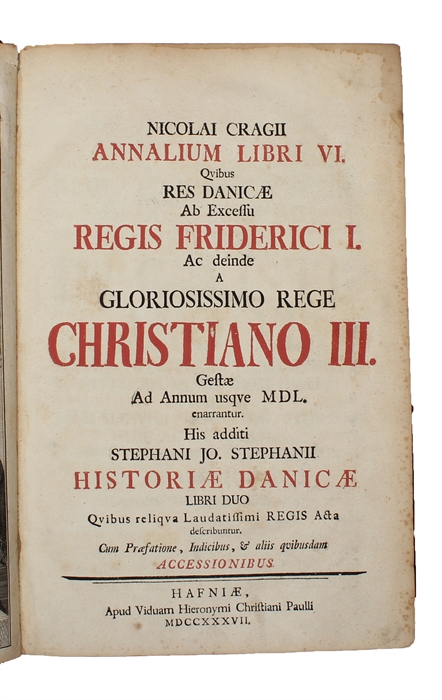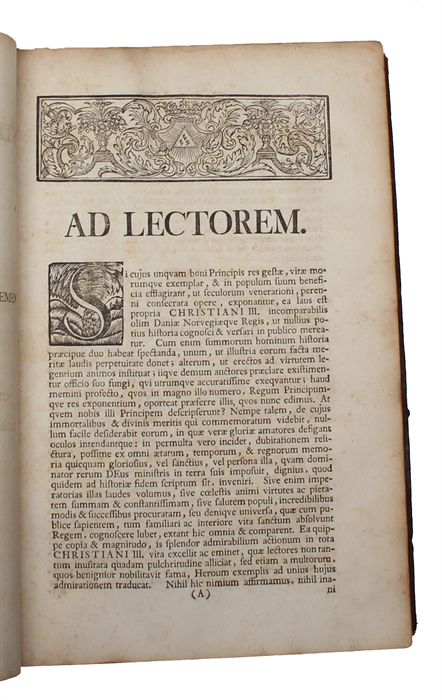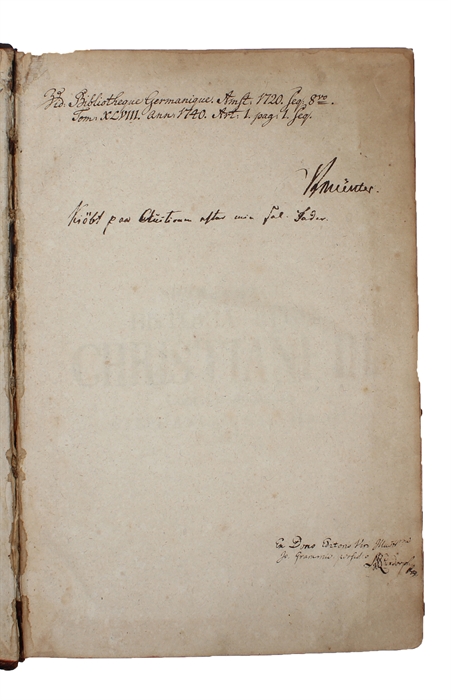GIFT-COPY FOR LUXDORPH
CRAGIUS, NIC. (NIELS KRAG).
Annalium libri VI. qvibus Res Danicæ ab excessu Friderici I. ac deinde a Christiano III. gestæ ad omnium usqve 1550 enarrantur. His additi Stephani Jo. Stephaniis Historiæ Danicæ libri duo quibus reliqua laudati Regis Acta describuntur. Cum Præfatione, Indicibus, & aliis qvibusdam.
Hafniæ, Paulli, 1737.
Folio. Contemporary full mottled calf with Luxdorph's blindstamped super ex libris to front board. Six raised bands to richly gilt spine. Spine and all extremities worn. A bit of leather missing at capitals, and cords showing at hinges. Even though the hinges are worn, the binding is still tight. Internally very nice and fresh with only very light occasional brownspotting. Front free end-paper with three annotations: 1) from the "Bibliotheque Germanique. Amst. 1720"; 2: Frederik Münter (noting that it was bought at the auction after his father); 3: Ex Dono-inscription by Luxdorph (perhaps the most important Danish book collector of all times), stating that the book was given him by Johannes Gram (the editor).
(42 - including half-title and frontispiece portrait (which is often lacking) ), 139, (1), 478, 136, (36) pp.
First edition, with an truly excellent provenance, of this important work of the history of Denmark, which due to Krag's untimely death only spans the first 16 years of the history of King Christian III. When Krag, the first official Danish historiographer, died in 1602, Krag had been working on the work throughout the 1590’ies. The manuscript was not finished and ended up remining unpublished for more than a century, until Hans Gram finally, in 1737, arranged for a beautiful edition of it to be printed. This wonderful first edition also contains other contributions to the history of King Christin III. Krag’s work is important in several ways. First of all, it focuses mainly on Danmark’s foreign relations during the period, making it an invaluable contribution to the history of Denmark’s international history of the late 16th century. Second, the work is both politically and linguistically important in its choice of Latin as the authorial language. It is written in an excellent classicist Latin that was to mark Denmark as part of the united European cultural sphere; in short, it was meant to represent Danmark as belonging to the civilized world. Krag’s excellent, stylized Latin history of Christian III constitutes the best example of applying classical historiography stylistically to the history of Denmark. The work is Roman in all its aspects. The vocabulary and the syntax are in accordance with classical Roman norms, and Krag also adopts the principle of the Roman historians of never quoting other text. The prose is his own all the way through. Also in his choice of relating the diplomatic relations of the King and the country, he stays true to the classical authors. Another noteworthy feature of this novel historical work is the fact that all Danish proper names are Latinized, not only cities, but also people (eg. the Danish nobleman Eske Bilde has been given the name Aeschylus). Crag took this so far that Hans Gram found it necessary to make an explanatory list of Crag’s Latinizations. ____________________________________________________________________________________ Provenance: The copy was given by the editor and publisher Johannes Gram to his student Bolle Luxdorph (1716-1788). Luxdorph was a famous Danish historian, poet, and state official. In bibliophile circles, however, he is most known as a book collector – one of the most important in the history of Danish book collecting. Bindings with his super ex libris (an elephant) are very sought after. Luxdorph was matriculated at the University of Copenhagen 1733 and had Hans Gram as private preceptor. He studied both theology, philosophy, classical philology, and history. Frederik Münter (1761-1830) was a famous Danish church historian, archaeologist, and Bishop of Sealand from 1808 till his death.
Order-nr.: 60954




